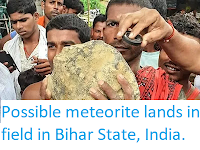A fragment of meteorite has been found in the village of Prečna near Novo Mesto, in southeastern Slovenia, which is thought to be a chunk of the object which exploded in the air above the country on 28 February this year (2020), and has been named the Novo Mesto Meteorite. The fragment was found by local resident Gregor Kos on his driveway on Wednesday 4 March, though he initially rejected the idea it was a meteorite on the basis that it was not magnetic, only reporting the find after reading about an organised search for such pieces by scientists in the local media, which was accompanied by pictures of similar rocks found elsewhere. It is thought highly likely that other fragments of the object will have fallen in the same area.
Chunk of meteorite found in the village of Prečna near Novo Mesto, in southeastern Slovenia, on 5 March 2020. Bojan Ambrožič.
The 28 February meteor was bright enough to be seen in daylight and exploded with a bang large enough to be detected by seismic monitoring stations in southern Slovenia. Objects
of this size probably enter the Earth's atmosphere several times a
year, though unless they do so over populated areas they are unlikely to
be noticed. They are officially described as fireballs if they produce a
light brighter than the planet Venus. The brightness of a meteor is caused by friction with
the Earth's atmosphere, which is typically far greater than that caused
by simple falling, due to the initial trajectory of the object. Such
objects typically eventually explode in an airburst called by the
friction, causing them to vanish as an luminous object. However this is
not the end of the story as such explosions result in the production of a
number of smaller objects, which fall to the ground under the influence
of gravity (which does not cause the luminescence associated with
friction-induced heating).
Meteorite-discoverer Gregor Kos holding the Novo Mesto Meteorite. Bojan Ambrožič.
These 'dark objects' do not continue along the path
of the original bolide, but neither do they fall directly to the ground,
but rather follow a course determined by the atmospheric currents
(winds) through which the objects pass. Scientists are able to calculate potential trajectories for hypothetical dark
objects derived from meteors using data from weather monitoring services.
See also...
Follow Sciency Thoughts on Facebook.








